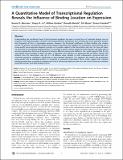| dc.contributor.author | MacIsaac, Kenzie Daniel | |
| dc.contributor.author | Lo, Kinyui Alice | |
| dc.contributor.author | Gordon, William | |
| dc.contributor.author | Motola, Shmulik | |
| dc.contributor.author | Mazor, Tali | |
| dc.contributor.author | Fraenkel, Ernest | |
| dc.date.accessioned | 2010-08-12T19:51:46Z | |
| dc.date.available | 2010-08-12T19:51:46Z | |
| dc.date.issued | 2010-04 | |
| dc.date.submitted | 2009-09 | |
| dc.identifier.issn | 1553-7358 | |
| dc.identifier.issn | 1553-734X | |
| dc.identifier.uri | http://hdl.handle.net/1721.1/57501 | |
| dc.description.abstract | Understanding the mechanistic basis of transcriptional regulation has been a central focus of molecular biology since its inception. New high-throughput chromatin immunoprecipitation experiments have revealed that most regulatory proteins bind thousands of sites in mammalian genomes. However, the functional significance of these binding sites remains unclear. We present a quantitative model of transcriptional regulation that suggests the contribution of each binding site to tissue-specific gene expression depends strongly on its position relative to the transcription start site. For three cell types, we show that, by considering binding position, it is possible to predict relative expression levels between cell types with an accuracy approaching the level of agreement between different experimental platforms. Our model suggests that, for the transcription factors profiled in these cell types, a regulatory site's influence on expression falls off almost linearly with distance from the transcription start site in a 10 kilobase range. Binding to both evolutionarily conserved and non-conserved sequences contributes significantly to transcriptional regulation. Our approach also reveals the quantitative, tissue-specific role of individual proteins in activating or repressing transcription. These results suggest that regulator binding position plays a previously unappreciated role in influencing expression and blurs the classical distinction between proximal promoter and distal binding events. | en_US |
| dc.language.iso | en_US | |
| dc.publisher | Public Library of Science | en_US |
| dc.relation.isversionof | http://dx.doi.org/10.1371/journal.pcbi.1000773 | en_US |
| dc.rights | Creative Commons Attribution | en_US |
| dc.rights.uri | http://creativecommons.org/licenses/by/2.5/ | en_US |
| dc.source | PLoS | en_US |
| dc.title | A quantitative model of transcriptional regulation reveals the influence binding location on expression | en_US |
| dc.type | Article | en_US |
| dc.identifier.citation | MacIsaac, Kenzie D. et al. “A Quantitative Model of Transcriptional Regulation Reveals the Influence of Binding Location on Expression.” PLoS Comput Biol 6.4 (2010): e1000773. © 2010 MacIsaac et al. | en_US |
| dc.contributor.department | Massachusetts Institute of Technology. Computer Science and Artificial Intelligence Laboratory | en_US |
| dc.contributor.department | Massachusetts Institute of Technology. Department of Biological Engineering | en_US |
| dc.contributor.department | Massachusetts Institute of Technology. Department of Electrical Engineering and Computer Science | en_US |
| dc.contributor.approver | Fraenkel, Ernest | |
| dc.contributor.mitauthor | MacIsaac, Kenzie Daniel | |
| dc.contributor.mitauthor | Lo, Kinyui Alice | |
| dc.contributor.mitauthor | Gordon, William | |
| dc.contributor.mitauthor | Motola, Shmulik | |
| dc.contributor.mitauthor | Mazor, Tali | |
| dc.contributor.mitauthor | Fraenkel, Ernest | |
| dc.relation.journal | PLoS Computational Biology | en_US |
| dc.eprint.version | Final published version | en_US |
| dc.type.uri | http://purl.org/eprint/type/JournalArticle | en_US |
| eprint.status | http://purl.org/eprint/status/PeerReviewed | en_US |
| dspace.orderedauthors | MacIsaac, Kenzie D.; Lo, Kinyui A.; Gordon, William; Motola, Shmulik; Mazor, Tali; Fraenkel, Ernest | en |
| dc.identifier.orcid | https://orcid.org/0000-0001-9249-8181 | |
| dspace.mitauthor.error | true | |
| mit.license | PUBLISHER_CC | en_US |
| mit.metadata.status | Complete | |
